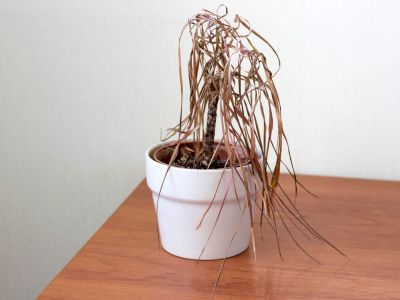Reasons Houseplants Die
If your indoor plants keep failing, it’s most likely due to cultural issues, many of which can be easily fixed.
Too Much Water
If you are watering too frequently, or your soil is taking too long to dry out, your plant can suffer from root rot and die. Some signs of root rot include a plant with leaves that are wilting. If you notice that your leaves are wilted and the soil feels moist, chances are that you have root rot. You may also see that your plant has yellowing leaves that are falling off, or fungus growing on the surface of the soil. To treat a plant that has suffered root rot, take your plant out of its pot, remove all the dead roots and as much of the potting soil that you can. Repot into a new container. Only water when the top inch (2.5 cm.) or so is dry.
Not Enough Water
The symptoms of not enough water can be the same as when the soil is too wet. Your plant may look droopy and have leaves that are falling off. When you notice these symptoms, feel the soil. If it is really dry, chances are that you are not providing enough water for your plant. Be sure to soak the soil when you water until water runs out of the drainage hole. Then wait until the top inch (2.5 cm.) or so is dry before watering again. In most cases, unless you have succulents, you don’t want to wait until ALL of the soil has dried out.
Bad Drainage
Your pot should always have a drainage hole. If you don’t, water can collect at the bottom of the pot and cause root rot. If your pot does have a drainage hole, take care to not let your container sit in a saucer full of water. If you don’t have a drainage hole, you can add one in the container or move the plant to a pot with adequate drainage and, if the other pot is a decorative one that is just slightly larger, you can place the newly potted plant inside it. After water has escaped the drainage hole, be sure to empty out any excess water that has collected in the saucer or pot that it’s sitting in.
Not Repotting
If you’ve had your houseplant in a pot for too long, over time the plant will become pot bound. The restricted conditions will eventually cause your plant issues. You should evaluate your houseplants about every year or two to assess whether or not it’s time for repotting.
Not Fertilizing
Houseplants need to be fertilized regularly. If your plant has been growing well for a while and you start noticing that the leaves are yellowing and growth has slowed down, this could be because you’re not fertilizing. Make fertilizing a regular part of your routine during the active growing season. On the flipside, take care not to overfertilize, which can be even more detrimental.
Not Enough Light
This one should go without saying. Plants need light to photosynthesize. If your houseplant looks weak, has sparse growth, smaller leaves and is far from a window, chances are that your houseplant is not getting enough light. Get to know the light requirements of each specific houseplant. If your plant needs additional light, simply move it. If you do not have suitable natural light, you may need to seek out supplemental lighting options, such as grow lights.
Pests
Pests, like spider mites and mealybugs, are common and it is important to detect them early before things get out of hand. If you notice any pests, wash your entire plant with warm water and then use an insecticidal soap. Be sure to cover all exposed surfaces of the plant.
